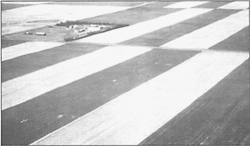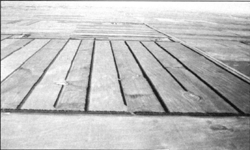Strip farming was widely practiced earlier this century, but the practice declined with the advent of large farm machinery. Strip farming, which is the practice of growing crops in strips which alternate with strips of summerfallow, reduces wind erosion by reducing the wind speed on the surface of the soil and the distance the wind travels across exposed summerfallow.
Where soil erosion is a problem, the benefits from strip farming outweigh the conveniences. The benefits of strip farming are less soil erosion and increased soil moisture from snow catch.
Methods for strip farming
There are various methods of rearranging fields into strips. The usual method is to start with fields to be summerfallowed. In a two- year, fallow-grain rotation the fields are first divided into strips of the desired width (see table). Every other strip is then seeded and the alternate strips are summerfallowed. For a three-year rotation, two strips are seeded and the third is summerfallowed. In light textured soils, fall rye should be seeded into stubble land in the fall. The following summer the fall rye strips may be left for grain or used for feed, while alternate strips are summerfallowed.

Properly designed strips are effective against wind erosion.
North/South strips are best
In most areas of Saskatchewan the prevailing wind direction is northwest or west. Therefore the best direction for strips for reducing the erosion potential is north and south. These strips reduce the exposure of summerfallow to the prevailing winds.
Strip widths and soil texture
The strip width required to combat wind erosion is determined mainly by soil texture.
| Soil Texture | Strip Width (meters) | # Of Strips in a Quarter Section |
|---|---|---|
| Sand | Perennial forages or cropped continuously | Perennial forages or cropped continuously |
| Sandy Loam | 50 | 16 |
| Heavy Clay | 80 | 10 |
| Loamy | 100 | 8 |
Very sandy soils require very narrow strips to effectively control soil drifting. This is usually impractical and such areas should be seeded to a protective grass - legume cover or continuously cropped using conservation tillage techniques.
Heavy clay soils can be prone to erosion. These soils readily slake down to a loose, granulated condition after freezing - and - thawing or wetting - and - drying. The loose soil granules are then subject to winds. Especially in the early spring, drifting may start over the entire field at the same time. Therefore, heavy clay soils should be striped farmed.
Keep field equipment sizes in mind
Producers should establish strip widths with equipment sizes in mind. Ensure strip widths are compatible with the widths of seeding, spraying and harvesting equipment.
With a little planning, a strip system can be devised which allows efficient use of farm machinery.
Special management concerns in strip farming
Experiences with strip farming have identified a number of special field management concerns. The most common is that solid ridges form on the windward side of stubble strips. The use of a wide- blade or heavy-duty cultivator to maximize residue cover on the summerfallow strips will minimize these ridges.
A second concern is that weed infestations and grasshopper populations mat occur along field margins. Proper chemical control of these pest can be concentrated on those strips affected. Strip margins can be shifted five metres either way to help alleviate both concerns.
Repeated travel along headlands to cultivate, speed, spray and harvest the various fields may pulverize the soil. Pulverized soil can initiate erosion which will often spread. Continuous cropping of the headlands is a means of avoiding this problem.
Implements can then be lifted to the ends of the field to minimize double working. Conservation tillage practices should be utilized to maintain residue cover on the soil surface.
Field shelterbelts and strip farming
Field shelterbelts make strip farming more effective. A good plan is to establish a tree belt along the edge of every second strip. Thus, where strips are a 100 metres wide, tree rows would be 200 metres apart. This arrangement provides an extra measure of soil erosion control without seriously hindering field work.

Field shelterbelts reduce soil erosion and provide wildlife habitat.
Single- row shelterbelts are most common in Saskatchewan for field erosion control. Caragana is the most popular species as it is very hardy and drought tolerant. Many farmers favour single-row caragana set 30 to 60 centimetres apart.
It is important to remember that shelterbelts require occasional maintenance, such as side mowing and weed control to keep them in good shape. The Prairie Farm Rehabilitation Administration Tree Nursery at Indian Head provides both expertise and free-of-charge shelter belt materials for prairie farmers.
Summary
- strip farming saves topsoil by reducing the wind's speed and distance of travel across summerfallow.
- the best time to implement a strip farming design is during the summerfallow year.
- strips should be arranged north and south for maximum erosion prevention.
- strip widths are dependent on soil type, wider for loams and narrower for clays and sands.
- consider machinery sizes when establishing strip widths for maximum convenience.
- very sandy soils should be continuously cropped or seeded to permanent forage cover.
- conservation tillage techniques should be practiced on all strips.
- strip margins can be shifted five metres either way to help overcome soil ridging and weed and insect problems.
- headland areas can be protected by continually cropping.
- supplement your strip farming program with fields shelterbelts.